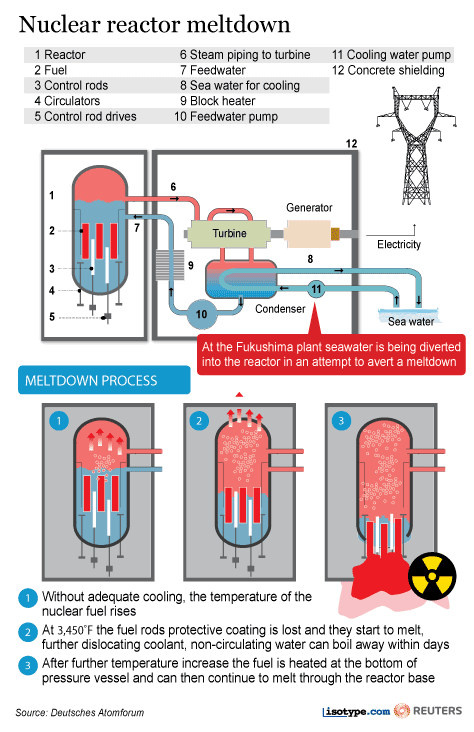We’ve been hearing on the news since the earthquake/tsunami/all around shitty time in Japan started. However, have you wondered why these explosions are happening? Well, I’ll attempt to explain it.
To break it down, fuel rods in a nuclear reactor are composed of zircoloid containing uranium dioxid The uranium used in nuclear power plants, uranium 235, is a highly charged, fissile element. When an element is fissile, it means it can sustain a fission chain reaction, so when the neutron (the tiny part of an atom that exists within the nucleus of said atom) touches another nucleus of uranium 235, a chain reaction occurs; causing energy release that can be harnessed via nuclear power plants. Now, as anyone who has ever broken a sweat by way of physical effort knows that energy release creates heat, thereby making these fuel rods, well, wicked hot.

Because these fission reactions can cause explosions, and to keep these rods from completely blowing up, the fission reaction is slowed down by control rods composed of boron, cadmium, and hafnium. These elements can absorb neutrons, slowing the collision of the nuclei, and diminishing the power of the uranium rods.
In fact, if they become hot enough, they can swell and crack, which would cause radioactive gases (caesium and iodine) to escape, which is bad news bears for everyone. So, a system had to be devised to keep these rods cool enough to; 1) not incinerate everyone in the area, 2) not melt a radioactive hole in the ground, and 3) not give everyone radiation poisoning.
And how do they do this? With water, glorious water – is there anything it can’t do? The Water is pumped into the reactor, which contains the insanely hot uranium rods, and is contained in a concrete housing. To give you an idea of how effective concrete can be in protecting us from radiation; it’s what is keeping the Chernobyl reactor sealed off after their disaster in 1986. Before you start to worry this will end up like Chernobyl, it’s not likely. The reactors in the Chernobyl plant were not surrounded by any remotely effective barrier, leaving everyone completely unprotected from any sort of accident. The Japanese know more, and are more careful than the people who ran the Chernobyl plant, so the risk is significantly lower. However, the potential danger of the situation should not be underestimated, and per the graphic I “borrowed” from MSNBC, who borrowed it from Reuters, it looks like even the concrete containment unit won’t be guaranteed to always be able to contain the melted uranium. There are several more things that have to happen for the situation to get to that point, but there’s a lot of chaos, a lot of danger, and a lot of unknowns at the moment.

*ahem* So, the reactor has pumps for both the control rods and the circulators which, surprise surprise, circulates the water around the rods which enables them to cool more effectively than standing water. The heated water turns into steam in the reactor, which is then pumped out through the turbine to the condenser where the steam is converted to water once again. Lather, rinse, repeat.
Because of the earthquake, the pumps in the reactor moving the cooling water failed, thereby allowing the uranium rods to overheat and produce excessive hydrogen-containing steam. As the rods continue to get hotter due to the lack of circulating water, steam increases, as does the pressure inside the reactor. The pressure then makes it impossible to pump more water into the reactor. So, the engineers, with the intention of avoiding a meltdown, allowed some of the steam to vent out of the reactor and into the environment. The downside is the steam releases radioactive elements into the environment, hence the warnings to stay indoors and/or evacuate.
Now how does all this relate to hydrogen? When the zircoloid tubes containing the uranium dioxide heat up, they react with the cooling water to form hydrogen which builds up in there steam. As anyone who is familiar with the Hindenberg knows, Hydrogen is extremely explosive, so excessive pressure inside the reactor+ a teensy bit of hydrogen escaping the reactor = big explosion.
If the water levels continue to drop within the reactor, the uranium rods will overheat and melt down through the reactor. The good news? The melted uranium will stay inside the concrete containment unit, as happened at Three Mile Island.
Is there more? Absolutely. Can I fill you in on more? Probably not much more than this without a ton of research, and they don’t pay me enough for that. In fact, if anyone else notes any inaccuracies in this article, please point them out in the comments. I did my best to explain this correctly, but being that my background in this includes a little college-level physics, a nuclear engineer bff, and a general curiosity for the subject matter. There are a number of good resources on both Japan’s nuclear plants as well as nuclear power on the internet from actual nuclear scientists that should be able to add more information, should you wish to seek it out.
World Nuclear News is an industry newsletter which has quite a bit of interesting information, as well as frequent news updates regarding the situation in Japan. Interestingly enough, they’re also on facebook.
In addition, many news websites have good information in relation to the incident. BBC News, Reuters, MSNBC, and Kyodo News have been rather informative.
Note: I am working today until 4PM EST without access to a computer. So if you comment and I don’t respond, it’s not because I don’t care, it’s because I can’t see it before 4. Where’s that computer chip for my brain?